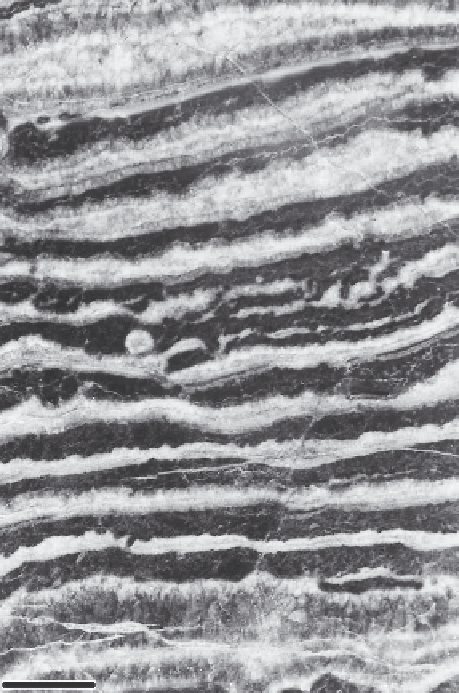Geology Reference
In-Depth Information
from microscopic to decimeter-sized, and may be
meters long. They may have simple cement fills or com-
plex banding of cement and internal sediment. Inter-
bedded dark micritic limestones and cm-sized, often
crinkled white calcite layers produce characteristic ze-
bra-like stripes in the rock. This fabric also occurs in
ancient beachrocks (Gray and Adams 1995) as well as
in Paleozoic carbonate mud mounds (Bosence and
Bridges 1995, Fig. 5.8). Although originally explained
as parallel sets of sheet cracks, current explanations
are just as vague as those for stromatactis, and include
collapse of thixotropic carbonate gels (Heckel 1972),
lithified crusts with winnowed-out intercrust layers,
cement-filled sheet cavities (Bathurst 1980), super-
posed microbial mats (Pratt 1982), or, soft sediment
dilation and deformation associated with slumping.
Krause (2001) put forward an interesting interpre-
tation of zebra fabrics and stromatactis structures of a
small Ordovician mudmound in Nevada. He compared
zebra and stromatactis limestones with structures trig-
gered by gas clathrate hydrates. In this scenario, the
carbonate cement layers would have precipitated and
stabilized the zebra and stromatactis fabric, both by
consolidating and dissociating gas clathrate hydrates,
and oxidizing and reduzing associated gases.
5.1.5.4 Significance of Birdseyes, Fenestral
Fabrics and Stromatactis
Open-space structures and fenestral fabrics should
be evaluated in terms of paleoenvironment and rela-
tive water depth, diagenetic history and associated res-
ervoir rock properties:
Paleoenvironmental proxies:
Birdseyes as well as
laminoid-fenestral fabrics occur preferentially in shal-
low near-coast supratidal and upper intertidal environ-
ments.
Birdseyes fabrics are not exclusively limited to
marine environment. They are also known from lacus-
trine carbonates and even from eolianites, where rain-
storm-induced fenestrae may occur high above sea level
(Bain and Kindler 1994).
Abundant stromatactis structures indicate deeper
subtidal environments but stromatactis formed in in-
tertidal settings must also be taken into account. Inter-
and subtidal setting of stromatactis are distinguished
by the composition of internal sediments, carbonate ce-
ment types and associated biota.
Diagenesis and reservoir potential:
The formation
and filling of open-space structures is critical in early
and burial diagenesis and porosity history (Bourque and
Raymond 1994; Grover and Read 1978; Mazzullo and
Birdwell 1989).
Fenestral porosity (see Sect. 7.3.1) is commonly as-
sociated with supratidal, mud-dominated bindstones
and mudstones. Primary fenestral porosity may be high,
up to 65% (Enos and Sawatsky 1981), and permeabil-
ity in birdseyes limestones can be increased signifi-
cantly by dolomitization opening communication be-
tween fenestral pores through intercrystalline porosity
in the matrix dolomite.
Fig. 5.8.
Zebra limestone
. The spectacular pattern of the rock
is characterized by alternations of dark wackestones and white
parallel layers consisting of several generations of calcite.
Some authors consider this fabric as a variation of stromatactis
fabrics, but zebra rocks should be discussed on their own
despite coincidences in supposed genetic interpretations and
the time range of occurrence (Cambrian to Jurassic). Pol-
ished section. Lower Late Devonian (Frasnian): Harz, Ger-
many. After Weller (1991). Scale is 1 cm.
Industrial use of fenestral limestones:
Devonian
reefs in Belgium and France yield spectacular red-col-
ored stromatactis limestones which are widely used as
decorative stones and for works of art.

